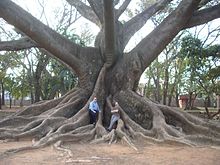




Buttress roots, also known as plank roots, are large, wide roots on all sides of a shallowly rooted tree. Typically, they are found in nutrient-poor tropical forest soils that may not be very deep. They may prevent the tree from falling over (hence the name buttress).
Buttresses are tension elements, being larger on the side away from the stress of asymmetrical canopies.[1] The roots may intertwine with buttress roots from other trees and create an intricate mesh, which may help support trees surrounding it. They can grow up to 30 feet (9 m) tall and spread for 100 ft (30 m) above the soil then for another 100 ft (30 m) below. When the roots spread horizontally, they are able to cover a wider area for collecting nutrients. They stay near the upper soil layer because all the main nutrients are found there.[2]
Buttress roots vary greatly in size from barely discernable to many square yards (square meters) of surface. The largest for which there is photographic evidence is a Moreton Bay Fig (Ficus macrophylla) at Fig Tree Pocket (an outlying district of Brisbane, Queensland) which was photographed in 1866 with an adult man. The buttresses were 40 to 50 ft (12 to 15 m) long and 35 to 40 ft (11 to 12 m) in height.[3] Halfway out the buttress is twice the height of the man. The tree died in 1893 from flood damage.
The tallest buttresses are those of Huberodendron duckei (Bombacaceae) of the Amazon basin which extend up to 70 ft (21 m) up a tree about 145 ft (44 m) in height.[4]
The most extensive buttresses are those of the Kapok, or Silk Cotton Tree (Ceiba pentandra), of the Neotropics and tropical Africa. The buttresses can extend outwards as much as 65 ft (20 m) from the tree as buttresses, then continue as superficial roots for a total of 165 ft (50 m).[5]


